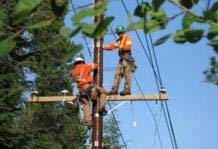By Sabrina Locicero

A pole replacement project completed late last year in Vancouver's Camosun Bog has helped protect the area's intensively studied ecosystem while also improving service reliability.
Using helicopters, BC Hydro collaborated with the British Columbia Transmission Corporation (BCTC) to replace nine aging wooden transmission poles near the Camosun Substation in Pacific Spirit Park with six fibreglass poles. The new poles are longer-lasting, which minimizes maintenance and access requirements as well as environmental impact.
Why fibreglass poles?
Cedar poles last 40 to 50 years, while fibreglass poles can last up to 120 years. This decreases the amount of maintenance that BCTC and BC Hydro will have to do throughout the lifespan of the poles.
They are also extremely flexible. In a heavily treed area such as Camosun Bog, these poles will be able to bend and flex in the event of trees striking the line. Again, this avoids having to replace wooden poles that have snapped from the weight of trees hitting the line.
The poles, which were pre-assembled near Camosun Substation, also have a minimal impact on the environment. Unlike wooden poles, fibreglass poles are chemically inert, will not decay and will resist woodpecker damage.
Removal & installation by helicopter
To reduce the environmental impacts of the project work, the BC Hydro-BCTC team worked with Metro Vancouver Regional Parks, the Camosun Bog Restoration Group and the Pacific Spirit Park Society. They agreed that using a helicopter to remove old poles and install new ones was the best option. This would avoid having to create new access to the bog area.
The team also minimized permanent ground disturbance by cutting the old poles above ground level. When the project was complete, 150 plants were installed at various sites to enhance affected habitat and to cover up the temporary walking trails that were made to access the pole sites throughout the bog.
Minor design changes were made by the team to mitigate impacts, such as moving the location of a new pole required to hold the distribution termination equipment. Working with the designers in the preconstruction phase allowed BCTC and BC Hydro to avoid disturbing a very wet and ecologically-rich part of the bog.
This project is an example of a project team making decisions that involve the community and local interest groups, using new technology, and being environmentally responsible to protect a rare ecosystem. By implementing measures to reduce environmental impacts, the team's collaboration has helped BC Hydro take an important step towards contributing to its Environmental Impact Goal (EIG), which aims for BC Hydro to have no net incremental environmental impact in the areas of land, water, air, and climate change by 2024 (compared to 2004).
Sabrina Locicero is a writer-editor with BC Hydro's Corporate and Employee Communications group.